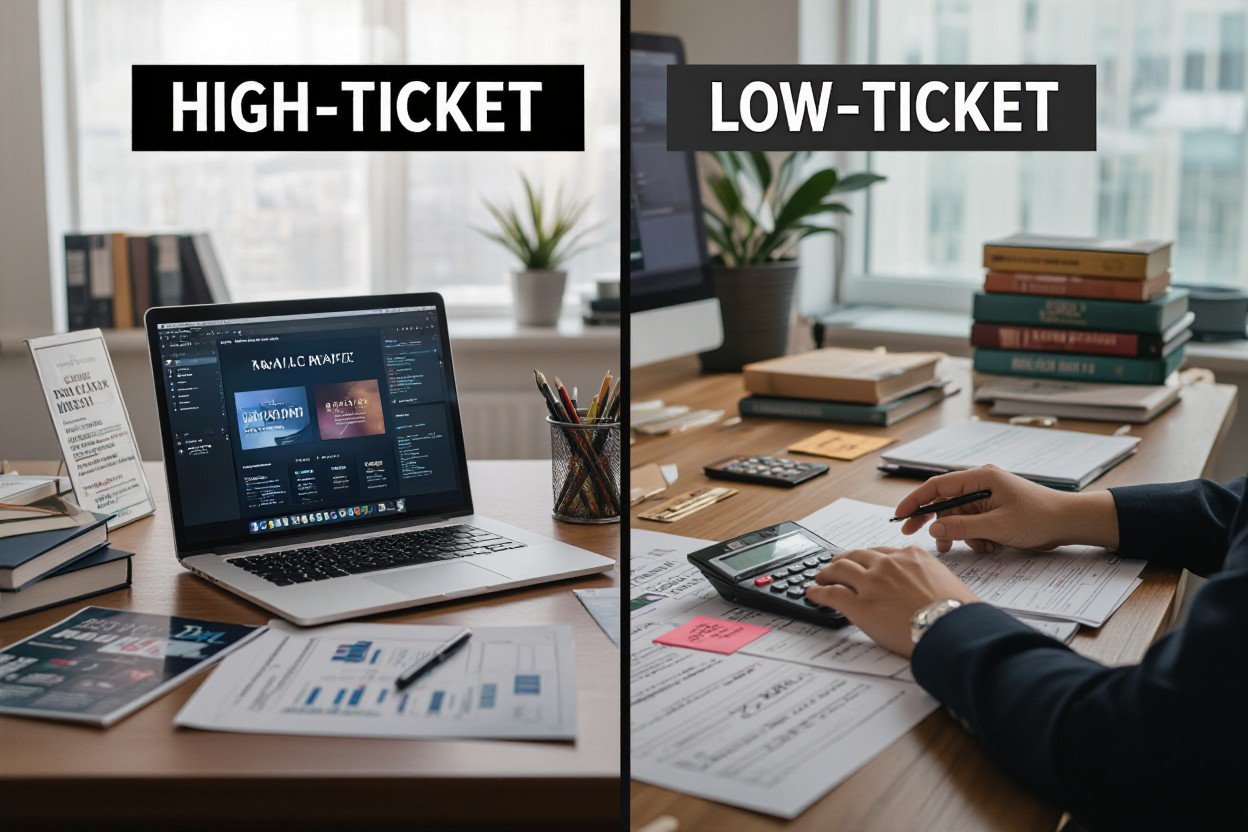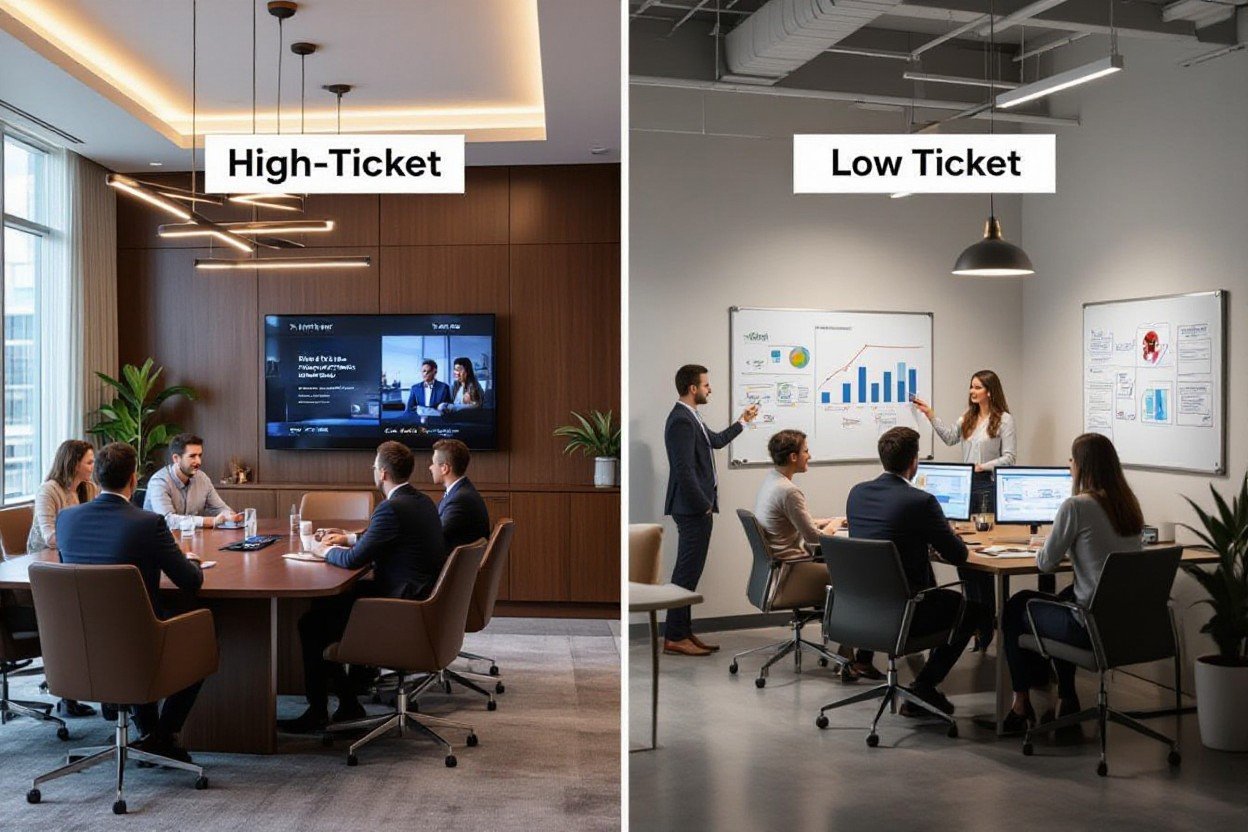
Overlooking the vast landscape of affiliate marketing opportunities, you’re faced with a pivotal choice that could shape your digital entrepreneurship journey. When deciding between high-ticket and low-ticket affiliate marketing, your potential earnings can vary dramatically based on your chosen path. While high-ticket products can bring in substantial commissions of $1,000 or more per sale, low-ticket items offer faster conversion rates and lower barrier to entry. Your success in either model depends largely on understanding your target audience, marketing capabilities, and the resources you can dedicate to your campaigns. This guide will help you navigate the key differences and make an informed decision for your affiliate marketing strategy.
Understanding the Pros and Cons of Each Model
As you weigh your options, it’s crucial to grasp the strengths and weaknesses of both high-ticket and low-ticket affiliate marketing. Each path offers unique benefits, but also distinct challenges. For instance, high-ticket items may demand more upfront effort to close a sale, yet they promise larger payoffs. Conversely, low-ticket items often convert quickly, but the earnings per sale are modest.
To help you navigate these complexities, we’ve created an Affiliate Conversion Rate Checklist. This powerful tool will guide you through the key factors that influence conversions. It equips you with actionable insights tailored to both high-ticket and low-ticket strategies. By using this checklist, you can sharpen your focus and enhance your approach, ensuring you make the most of your efforts in whichever affiliate model you choose.
Now, let’s dive deeper into the specifics of high-ticket and low-ticket affiliate marketing. We’ll explore how each model works, the types of products involved, and how you can align your strategy with your business goals.
Key Takeaways:
- High-ticket affiliate marketing offers larger commissions (hundreds to thousands per sale) but requires longer sales funnels and more extensive lead nurturing
- Low-ticket affiliate programs succeed through higher sales volume and faster conversions, making them ideal for marketers focusing on quick turnover
- Buyer psychology differs significantly – high-ticket customers need more trust-building and value demonstration, while low-ticket buyers focus on convenience and quick decisions
- Success in either model depends heavily on your niche, content strategy, and target audience characteristics
- ROI potential exists in both approaches – high-ticket through substantial individual commissions, low-ticket through frequent smaller sales and higher conversion rates
The Financial Dynamics: Profit Margins and Commission Structures

Commission structures fundamentally shape your earning potential in affiliate marketing. High-ticket programs typically offer commission rates between 30-50%, translating to substantial earnings per sale, while low-ticket items generally provide commissions of 5-15%. Your total revenue potential depends on factors like market demand, conversion rates, and your promotional capabilities. Understanding these financial mechanics helps you build a sustainable affiliate business model aligned with your goals.
Analyzing High-Ticket Commission Benefits
High-ticket affiliate programs deliver powerful earning potential with fewer sales. A single conversion of a $2,000 product at 40% commission yields $800 – equivalent to selling eighty $10 products at 10% commission. These programs often include recurring commissions, creating passive income streams through subscription-based services. Your promotional efforts focus on quality over quantity, allowing deeper engagement with potential customers.
Rapid Gains in Low-Ticket Sales Strategy
Low-ticket affiliate marketing thrives on volume and quick turnover. The lower price points mean faster customer decisions and shorter sales cycles. You can typically generate consistent income through multiple small commissions, especially in popular niches like consumer electronics or fashion. The key advantage lies in the lower resistance to purchase, making it easier to convert browsers into buyers.
Success in low-ticket affiliate marketing often stems from diversification across multiple products. Smart marketers leverage automated systems and email marketing to promote various items simultaneously, creating multiple revenue streams. The strategy works particularly well with impulse purchases and seasonal products, where you can capitalize on trending items and holiday shopping sprees. Your focus should be on building a robust traffic system that consistently drives new potential customers to your affiliate offers.

Psychological Triggers: Buyer Behavior Insights
Understanding buyer psychology reveals distinct patterns in purchasing decisions across different price points. Research shows that emotional triggers drive 95% of purchasing decisions, regardless of price point. The key difference lies in how these emotions manifest – from quick gratification in low-ticket items to deep value assessment in high-ticket purchases.
Deciphering High-Ticket Buyer Motivation
High-ticket buyers exhibit specific behavioral patterns driven by status, long-term value, and transformation potential. These customers spend an average of 2-3 weeks researching before making a purchase decision. Your success in this space depends on addressing their core desires for expertise, premium quality, and substantial results. Social proof, detailed case studies, and comprehensive product demonstrations become your most powerful conversion tools.
The Urgency and Ease for Low-Ticket Customers
Low-ticket purchases operate on impulse and immediate problem-solving needs. These buyers make decisions within 24 hours of their initial product discovery. Your marketing should emphasize quick wins, instant gratification, and hassle-free solutions. Price comparisons, limited-time offers, and straightforward benefit statements drive these conversions most effectively.
The psychology behind low-ticket purchases reveals that scarcity marketing tactics increase conversion rates by up to 50%. Your customers respond strongly to countdown timers, limited quantity alerts, and flash sales. They’re also more likely to make additional purchases when offered upsells under $27, creating opportunities for increasing average order value while maintaining the low-risk appeal that attracted them initially.

Conversion Pathways: Navigating the Sales Funnel
Sales funnels for high-ticket and low-ticket items follow distinctly different paths to conversion. Your high-ticket funnels typically require multiple touchpoints and extensive trust-building, while low-ticket funnels focus on quick, friction-free purchasing decisions. Understanding these pathways allows you to design targeted content and promotional strategies that align with your chosen affiliate model’s conversion requirements.
Crafting the High-Ticket Sales Experience
High-ticket sales funnels demand a sophisticated approach with multiple value-adding touchpoints. Your funnel might start with detailed blog posts or comprehensive video reviews, progress through email nurturing sequences, and culminate in personalized webinars or consultation calls. These multiple steps help justify the higher price point and build the necessary trust for significant purchases.
Streamlining the Low-Ticket Purchase Process
Low-ticket conversion paths thrive on simplicity and immediacy. Your focus should be on creating clear, direct routes to purchase with minimal steps between interest and checkout. Product comparisons, quick-reference guides, and straightforward benefit statements work best for these faster-moving sales cycles.
The efficiency of your low-ticket funnel depends on removing friction points and maintaining momentum. Consider implementing one-click ordering options, mobile-optimized landing pages, and instant delivery systems. Your product reviews should be concise yet informative, focusing on immediate benefits rather than long-term value propositions. Many successful low-ticket affiliates use urgency triggers like limited-time discounts or bonus offers to encourage quick buying decisions.
ROI Analysis: Balancing Time Investment and Returns
Your time investment in affiliate marketing directly impacts profitability across both models. High-ticket programs demand 15-20 hours per week of content creation, relationship building, and funnel optimization, while low-ticket strategies typically require 25-30 hours weekly focused on traffic generation and conversion optimization. The ROI calculation must factor in not just commission rates but also your content development costs, advertising spend, and the time spent nurturing leads to conversion.
Evaluating Long-Term Gains from High-Ticket Sales
High-ticket affiliate programs often yield substantial recurring revenue through subscription-based products or service upgrades. A single successful high-ticket conversion can generate $500-$2000 in commission, potentially delivering ongoing monthly income. Your initial investment in building authority and trust pays off through higher customer lifetime value and reduced acquisition costs over time.
The Volume Play: Profitability in Low-Ticket Models
Low-ticket affiliate marketing thrives on scale and efficiency. With commission rates typically ranging from $5-50 per sale, success depends on streamlining your marketing processes and maximizing traffic. Your focus shifts to optimizing conversion rates across multiple products, potentially reaching 100+ sales monthly through diversified traffic sources.
The mathematics of low-ticket success relies on maintaining consistent traffic flow and conversion rates. By promoting multiple complementary products, you can achieve cross-selling opportunities that boost average transaction values. Smart email marketing automation and retargeting campaigns help maintain steady sales volume while reducing your daily hands-on management time.
Tailored Marketing Approaches: Aligning Strategies with Audience
Your marketing approach must align precisely with your chosen affiliate product tier. Different price points demand distinct promotional strategies, content types, and audience engagement methods. The key lies in matching your marketing tactics to your audience’s purchasing behavior and decision-making process, whether they’re quick-buy impulse shoppers or careful researchers of premium solutions.
Building Trust for High-Ticket Conversions
High-ticket success hinges on establishing deep credibility through detailed product reviews, case studies, and comprehensive comparison guides. Your content should showcase expert knowledge and address specific pain points that justify the higher investment. Focus on creating in-depth video demonstrations, expert interviews, and data-backed testimonials that validate the premium price point.
Engaging Techniques for Low-Ticket Offers
Low-ticket promotions thrive on quick-action triggers and simplified buying processes. Your marketing should emphasize immediate benefits, time-limited deals, and straightforward value propositions. Social proof through user reviews and basic product demonstrations can quickly convince buyers to make low-risk purchases.
The most effective low-ticket strategies leverage urgency marketing techniques and rapid-fire content delivery. You’ll want to maintain a consistent presence across multiple platforms, using eye-catching visuals, short-form videos, and engaging social media posts. Email marketing campaigns should focus on flash sales, limited-time discounts, and bundle offers that encourage immediate action. Consider implementing countdown timers, stock limitations, and seasonal promotions to drive quick conversion decisions.
To wrap up
Presently, your success in affiliate marketing hinges on aligning your chosen model with your strengths and resources. You’ll find that high-ticket programs can deliver substantial commissions but demand more effort in nurturing leads and building trust. Meanwhile, your low-ticket affiliate ventures might offer quicker conversions and steady income through volume sales. By evaluating your target audience, marketing capabilities, and preferred selling style, you can select the model that best fits your business approach. Whether you opt for high-ticket luxury items or low-ticket consumer goods, your focus should remain on delivering value and maintaining authenticity in your promotional efforts.
FAQ
Q: What are the main differences in commission structures between high-ticket and low-ticket affiliate marketing?
A: High-ticket affiliate marketing typically offers commissions ranging from $500 to $5,000+ per sale, often with recurring revenue potential. Low-ticket programs usually provide commissions between $1 to $50 per sale but generate higher sales volumes. High-ticket programs generally offer commission rates of 30-50%, while low-ticket programs might offer 5-15% of the product price.
Q: How do conversion rates compare between high-ticket and low-ticket affiliate products?
A: Low-ticket products typically convert at rates of 2-5% due to lower risk and faster decision-making by customers. High-ticket items usually convert at 0.5-2% because buyers need more time to research and consider their purchase. However, high-ticket sales compensate for lower conversion rates with significantly higher commission values.
Q: What marketing skills are required for each type of affiliate marketing?
A: High-ticket affiliate marketing requires advanced copywriting, relationship building, and extensive product knowledge to establish trust and authority. Low-ticket marketing focuses more on traffic generation, basic promotional skills, and quick engagement techniques. Both require SEO knowledge, but high-ticket demands more sophisticated content marketing strategies.
Q: How long does it typically take to see results in each model?
A: Low-ticket affiliate marketing often shows initial results within 1-3 months, with regular small commissions coming in frequently. High-ticket programs typically take 3-6 months to generate consistent sales due to longer sales cycles and the need to build credibility. However, one high-ticket sale can equal months of low-ticket commissions.
Q: What investment is needed for high-ticket versus low-ticket affiliate marketing?
A: Low-ticket affiliate marketing can start with minimal investment, often $100-$500 for basic tools and advertising. High-ticket marketing typically requires $1,000-$3,000 initial investment for premium tools, advanced training, and higher-quality marketing materials. The higher investment in high-ticket marketing reflects the need for professional presentation and sophisticated marketing strategies.
